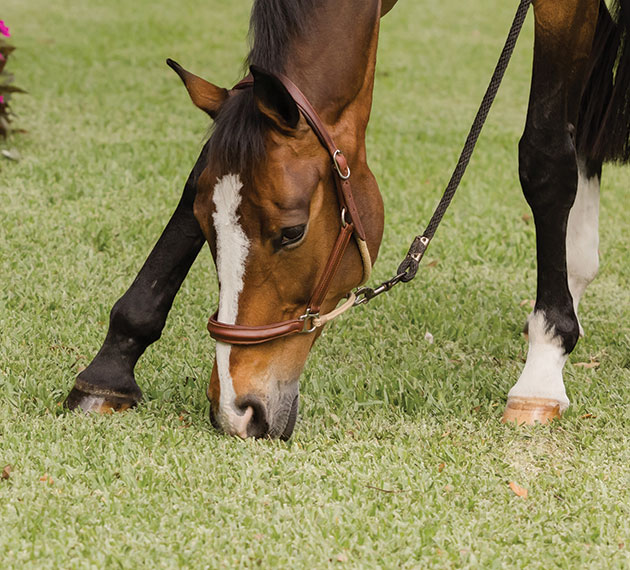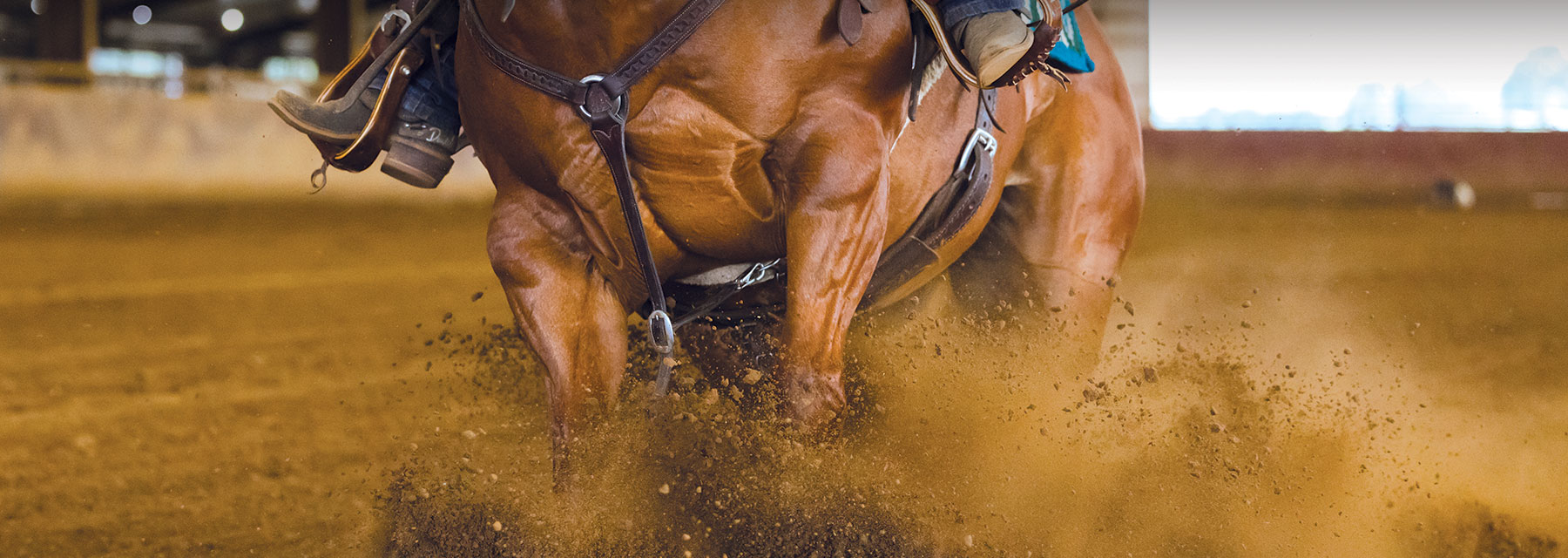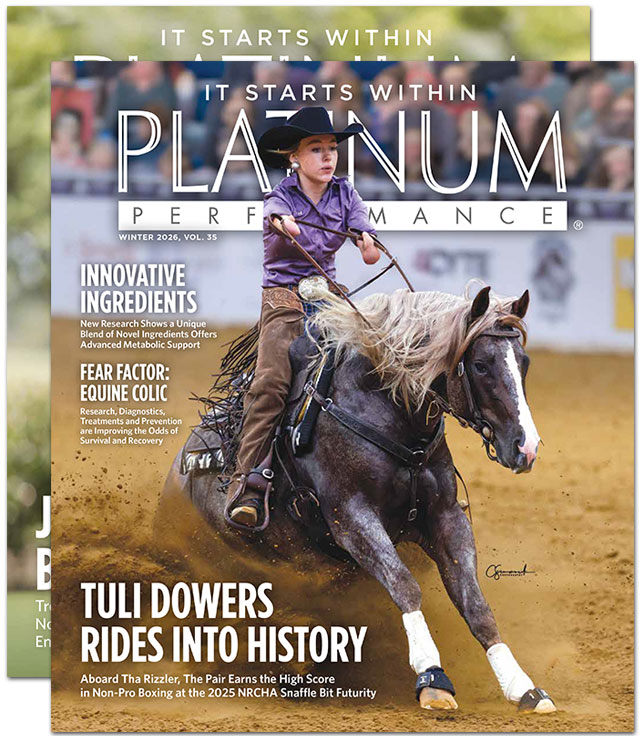Beyond Body and Muscle Structure, Protein is an Integral Component of the Immune System, Necessary in Nutrient Transportation, Hormonal Synthesis and More
Protein captures the attention of horse owners. Many people think it is the most important nutrient in a horse feed, or one that makes horses hot, or something that boosts the animal’s weight. However, these inaccurate attributes are not what makes protein critical to every horse. From the Greek word proteios, meaning “of primary importance,” protein makes up over 70% of the body’s total moisture-free composition with up to 55% being muscle mass. While protein is often synonymous with its structural role in muscling and topline, it is also an integral component of the immune system, necessary for the transport of nutrients across membranes and in the blood, and has hormonal functions. It is a major component of every cell in the body and serves significant functions in most areas of horse health.
In the wild, horses are able to consume a variety of feeds that contain a spectrum of nutrients — including protein. Grazing on different types of grasses, seed heads, flowers, leaves, legumes, bark and more provide a high-fiber and balanced diet. However, contemporary feeding has upended the natural diet. Now, horses are primarily fed the same meal with the same ingredients day after day. Because of this, it is important to know what the diet is providing to your horse on a daily basis, so all of his requirements are being supplied to ensure wellness, longevity and overall health.
Of the more than 500 amino acids in nature, there are 21 primary amino acids used as building blocks for proteins (as well as peptides, protein’s smaller counterparts) in the horse’s body. When a horse consumes protein, the body breaks apart the peptide bonds linking proteins together to release individual amino acids that are absorbed in the bloodstream for a variety of functions throughout the body. These individual amino acids are what the horse actually requires. Amino acids are typically classified on whether they must be consumed in the diet (essential amino acids) or if the body is capable of synthesizing them and in quantities sufficient enough to meet requirements (non-essential amino acids). Ten essential amino acids must be provided daily in the diet due to the animal lacking metabolic pathways for synthesis. These are: lysine, methionine, threonine, isoleucine, leucine, histidine, phenylalanine, valine, arginine and tryptophan. There are also several other amino acids considered conditionally essential amino acids meaning they are generally able to be synthesized but more may be required if, for example, a horse is stressed or ill, or if the horse does not consume enough of a precursor amino acid.
When a horse consumes protein, the body breaks apart the peptide bonds linking proteins together to release individual amino acids that are absorbed in the bloodstream for a variety of functions throughout the body. These individual amino acids are what the horse actually requires.
Key Body Functions of Protein and Peptides
- Skeletal muscle synthesis for growth and repair
- Provide structure (bones, collagen, keratin, tendons, ligaments)
- Hormones (insulin, glucagon, some reproductive hormones)
- Nutrient transport in the blood (hemoglobin, albumin)
- Nutrient transport across the cell membrane
- Metabolic regulation (enzymes, peptide hormones, neurotransmitters)
- Immune system (immunoglobulins, cytokines)
- Buffer for body pH fluctuations
What is Crude Protein?
Crude protein is an estimate of the total protein content. Crude protein is based on a measurement of nitrogen that is multiplied by 6.25 (since the average nitrogen content of proteins was found to be about 16%); this is the crude protein amount seen on a feed tag. For reference, alfalfa hay tends to have a crude protein range of 19-23% while most grass hays average about 7-14%. A hay with a crude protein level below 10% may be considered less desirable but can still be useful as not all types of horses need high-protein hay to thrive. An overweight horse may do very well on a less rich hay where calories and protein provided are lower and fiber content is higher, but the horse can still consume it throughout the day for digestive health. For most adult horses, a crude protein level of 10-14% on a dry matter (DM) basis from hay will provide maintenance protein requirements when fed at about 2% of their body weight. What a crude protein value does not tell you is protein quality or digestibility.
General Crude Protein Recommendations
Based on a 1,100 lb Horse (NRC, 2007)
Life Stage: Maintenance, Early Gestation or Light Work
Needs: ~1-1.5 lb protein (540-720 g)
Sample Feed: 2% body weight of pasture grazing or quality grass hay. Feed a forage-based diet to maintain body condition.
Life Stage: Moderate to Heavy Work
Needs: ~1.7-2.1 lbs protein (768-1,004 g)
Sample Feed: Pasture and/or free choice quality grass hay or grass/alfalfa blend hay. Use a 14% CP fortified feed to maintain body condition depending on activity.
Life Stage: Broodmare (Late Gestation, Pregnancy Months 8-11)
Needs: ~2 lbs protein (759-893 g)
Sample Feed: Pasture and a grass/alfalfa blend hay with 2-4 lbs of a 14-16% CP feed.
Life Stage: Broodmare (Early Lactation, Months 1-3)
Needs: ~3.2-3.4 lbs protein (1,468-1,535 g)
Sample Feed: Pasture and/or free choice 50/50 grass/alfalfa blend hay. Use a 14-16% CP feed or a 30% CP balancer to maintain body condition.
Life Stage: Broodmare (Late Lactation, Months 4+)
Needs: ~2.7-3 lbs protein (1,265-1,398 g)
Sample Feed: Pasture and/or free choice 50/50 grass/alfalfa blend hay. Use a 14 to 16% CP feed or a 30% CP balancer to maintain body condition.
Life Stage: Weanlings
Needs: ~1.5 lbs protein (676 g)
Sample Feed: Pasture grazing and/or 50/50 grass/alfalfa blend hay with a 30% CP balancer.
Life Stage: Yearlings
Needs: ~1.9 lbs protein (846 g)
Sample Feed: Pasture grazing and/or 50/50 grass/alfalfa blend hay with a 30% CP balancer.
Life Stage: Breeding Stallion
Needs: ~1.7 lbs protein (789 g)
Sample Feed: Pasture and/or quality grass hay or a grass/alfalfa blend hay. Use a 14% CP feed to maintain body condition through breeding season.
What Makes a Protein “High Quality”?
For the body to synthesize proteins, all amino acids must be present in a balanced ratio. The body can’t store amino acids. If one of the essential amino acids is missing or there is not enough available, protein synthesis halts. The amino acid that is likely to first “run out” relative to the horse’s needs is often referred to as the limiting amino acid. In horses, this is usually lysine followed by methionine and threonine. For instance, if a protein source is naturally low in lysine, it is considered a low-quality protein, even if it contains a high crude protein percentage. Protein referred to as high quality contains the essential amino acids in adequate rates and proper ratios for protein synthesis.
The National Research Council (NRC), the operating arm of the U.S. National Academies of Sciences, Engineering, and Medicine, private (nonprofit) institutions that provide expert advice on some of the most pressing challenges facing the nation and world, provides the current equine nutritional requirements. As of 2007, the NRC has recommendations for protein intake as crude protein and lysine. Digestibility and bioavailability, or how well something is absorbed, are other factors of protein quality to consider.
At the top of commercial feed tags, crude protein data offers a general idea of total protein content in a feed, but it does not give information about the protein’s quality nor digestibility. Not all protein sources are created equal, but the balance of amino acids in the feed is most important. Alfalfa, soybean meal, whey, flaxseed meal, beet pulp and brans are quality protein sources and often added to commercial feeds to round out the overall amino acid profile. The quality of the protein is important because if an equid’s daily diet is low in one or more essential amino acids, it can hinder protein synthesis. This can lead to a protein deficiency affecting growth, performance and lactation in mares. Interestingly, research has shown that horses grow more slowly on lysine-deficient diets than high-lysine diets, even with identical crude protein percentages. The availability and balance of the amino acids are more important than the general crude protein intake. For example, the amino acids lysine, threonine or methionine may be deficient even when the total crude protein in the diet is adequate.
Crude Protein in Common Feeds
| Forages | Percent CP Range |
|---|---|
| Alfalfa (hay, cubes or pellets) | 19-23% |
| Beet pulp | 7-11% |
| Grass hay, warm season (Bermuda, Coastal, Tifton) | 8-13% |
| Grass hay, cool season (brome, orchardgrass, timothy, fescue) | 5-15% |
| Oat hay | 5-11% |
| Rice bran | 11-19% |
| Rice bran | 3-7% |
| Soybean hulls | 12-16% |
| Wheat bran | 15-20% |
| Wheat hay | 7-14% |
| Wheat middlings | 17-19% |
| Concentrates | Percent CP |
|---|---|
| Barley | 9-14% |
| Canola meal | 35-44% |
| Corn | 7-10% |
| Flaxseed meal | 31-35% |
| Oats | 11-15% |
| Soybean meal | 44-52% |
| Wheat | 11-16% |
* National Research Council (2007) and Equi-Analytical Laboratory Services
Protein requirements are based on a horse’s age, life stage and activity level.
How Much Protein Does My Horse Need in His Diet?

High-performance horses require extra protein to recover and rebuild muscle, as well as replace losses from sweat.
High-performance horses require extra protein to recover and rebuild muscle, as well as replace losses from sweat.
Protein requirements are based on a horse’s age, life stage and activity level. Some life stages, such as lactating mares, have a huge demand for dietary protein. Broodmares in late gestation require extra protein in the diet to support the building of placental tissue and fetal growth. Early lactation requires greater amounts of protein for milk production. Weanlings and yearlings are constantly building bone and muscle. High-performance horses require extra protein to recover and rebuild muscle, as well as replace losses from sweat. Current protein requirements per the NRC include crude protein (CP) in both grams and as a percentage of diet on a dry matter (DM) basis. The only current amino acid requirement is for lysine which is also estimated in grams per day and as a percentage. For example, the NRC suggests a 500 kg (1,100-pound) adult horse at maintenance requires a minimum of 650 g (1.4 pounds) crude protein daily. A horse that consumes about 2% of his body weight— about 22 pounds—by pasture grazing or eating quality grass hay will likely consume this much protein per day without supplementation. A general suggestion is to provide 10-14% crude protein from a variety of sources into the daily diet for adult horses at maintenance. Growing foals and lactating mares will require around 16-18% total protein in the daily diet.
Alfalfa: A Protein Powerhouse
Example: You feed 20 pounds of a coastal bermudagrass hay with a 10% crude protein value. You also feed 4 pounds of a 14% protein commercial feed.
You want your horse’s daily diet to provide a total of 14% crude protein.
Grass hay: 20 pounds x 454 grams/pound x .10 = 908 grams protein
Commercial feed: 4 pounds x 454 grams/pound x .14 = 254 grams protein
Total grams of protein in 24 pounds (same as 11,350 grams) of feed: 908 + 254 = 1,162 grams
Percent protein in the diet: 1,162/11,350 x 100 = 10.23%
**Replace 10 pounds of grass hay with 10 pounds of alfalfa hay**
Grass hay: 10 pounds x 454 grams/pound x .10 = 454 grams protein
Commercial feed: 4 pounds x 454 grams/pound x .14 = 254 grams protein
Alfalfa hay: 10 pounds x 454 grams /pound x .20 = 908 grams protein
Total grams of protein in 24 pounds (same as 11,350 grams) of feed = 454 + 254 + 908 = 1,616 grams
Percent protein in the diet: 1,616/11,350 x 100 = 14.23%
Common Sources of Protein & How to Feed
Forage, including pasture and hay, is the main protein source for most horses. Legume sources, including alfalfa and clover, generally have a higher-quality protein content compared to grasses and grass hays. Grass and grass hays have a wide range of protein values depending on type of grass, plant maturity, time of harvest, precipitation, soil type, etc. Having a pasture or hay analysis will tell you the crude protein and lysine values.
Whey protein is an easily absorbed complete protein that is simple to digest and contains all of the essential amino acids. Whey also supports the immune system and provides antioxidant benefits.
Soybean meal is a legume and has a crude protein level of 44-52% with a good balance of essential amino acids, including a high lysine content. As a commodity, it can be a less expensive source of protein.
Beet pulp, flaxseed meal and stabilized brans are quality protein sources as well.
Some feeds are simply fortified with lysine to boost their amino acid profile. Cereal grains have varying levels of protein and are often high in sugar, starch and calories. Commercial feeds tend to combine sources to meet the intended overall protein content.
For foals, mare’s milk is an excellent source of protein and amino acids.
To ensure quantity and quality, feed several protein sources. Provide two or more types of hay, or purchase hay that is a blend of grasses. If you feed a commercial feed, check the ingredient list for multiple protein sources, such as alfalfa meal, soybean meal, wheat middlings, various brans and flaxseed.
Protein Deficiency and Excess
Dietary protein needs to be fed in sufficient quantities and with a quality amino acid profile necessary for the growth, maintenance or repair of body tissues dependent on the individual horse. Consuming enough general protein is usually not at issue for horses on a normal forage-based diet, especially if energy needs are being met (i.e. the horse is maintaining body condition). Even lower-quality grass hays tend to provide enough percent crude protein to meet minimum requirements. However, it is possible for one or more of the individual amino acids to be deficient, usually lysine and/or methionine. Without adequate amounts of all the amino acids, proteins will not be made and body tissues can suffer. Any available amino acids will be prioritized for vital organs. A true protein deficiency can be seen as weight loss, low immune function, loss of muscle mass, diminished growth rate, poor appetite and poor skin and coat health. Hoof quality can be a sign of lacking dietary protein with shelly hooves that crack or chip easily or do not grow. Undersupplied protein levels can also result in poor performance and recovery.
Excess dietary protein is more likely than a deficiency in modern equine feeding practices, but more does not mean better. Too much protein that cannot be used in the body will be broken down and excreted as urea in the urine. For a healthy adult horse, high levels of protein are not overly concerning in the short term. In addition to the extra expense of overfeeding protein, excess ammonia from increased excretion can irritate the respiratory system and create breathing issues in stabled horses. Equines with liver or kidney issues may need to have their protein levels limited as high levels of protein can tax the liver and kidneys, cause dehydration and lead to mineral imbalances, specifically of calcium, phosphorus and magnesium. In general, avoid feeds with elevated protein content unless you are feeding a horse that requires it such as a young, growing animal, a lactating mare or a high-performance athlete. A general recommendation for a healthy adult horse is a diet that contains 12-14% crude protein from multiple protein sources.
Myth Buster: High levels of protein in the diets of young horses are not linked to developmental orthopedic disease, or DOD. Nutritional correlations with DODs are from major mineral imbalances as well as overfeeding energy (calories), especially as sugar and starch.

The Amino Acids
Essential amino acids are those that cannot be produced within the horse and must be consumed in the diet.
- Lysine
- Histidine
- Methionine
- Phenylalanine
- Threonine
- Valine
- Isoleucine
- Arginine
- Leucine
- Tryptophan
Conditionally essential amino acids are non-essential amino acids that the body can usually make but may not be able to keep up with demand during times of stress or illness.
- Cysteine
- Glutamine
- Glycine
- Tyrosine
- Proline
Non-essential amino acids can be synthesized by the horse’s body.
- Alanine
- Glutamate
- Aspartate
- Asparagine
- Serine
- Selenocysteine
Protein and Hoof Health
Protein makes up over 90% of the hoof wall on a dry matter basis. Protein-deficient diets lead to general poor hoof quality as shown by reduced hoof growth and splitting or cracking of the hoof. Hoof tissue contains a variety of amino acids that affect the metabolism of the hoof and must be available in appropriate dietary amounts. Digestible and high-quality protein supplies the horse with the amino acids necessary for growth and tensile strength.
Lysine and methionine are essential for hoof growth as they are necessary for producing all body proteins including keratin — the major structural protein for the hooves, as well as skin, mane and tail. It is responsible for the outer protective layer of the hoof wall as well as structural support. Keratin, keratin-associated proteins and the intercellular cementing substance are all made primarily from amino acids, which are used to synthesize these structural proteins in the hoof wall.
The sulfur-containing amino acids, cystine, cysteine and methionine, play a key role in the development of the “cellular envelope,” also known as the marginal band, that protects horn cells against protein-degrading enzymes. Cystine and cysteine can actually be synthesized internally from methionine. The pathway that converts methionine to cysteine is thought to be imperative in the maintenance of a quality hoof. Methionine is a diet-dependent amino acid since it cannot be manufactured from other amino acids as is the case for several others. It is necessary for integrity of the white line, and, along with lysine, is essential for hoof growth. As a primary constituent of keratin, methionine stimulates strong, healthy hoof growth and is essential to prevent cracked, brittle hooves.
What are Branched Chain Amino Acids?
Popularized by human athletes, the branched chain amino acids — leucine, isoleucine and valine — may provide support for equine athletes as well. Supplementation with these special essential amino acids may support the sparing of dietary carbohydrates and glycogen used for energy. They may also help to delay the onset of fatigue and support a horse's ability to maintain muscle tissue, tone and glycogen stores.
Does Protein Make My Horse “Hot”?
While being the first ingredient listed on a feed tag, protein actually is not the most efficient source of energy to support body condition, nor is it the preferred fuel source for the body. Unlike carbohydrates and fats, protein should not be fed to provide energy. Even when fed in excess, protein is a very inefficient energy source for the horse. It requires more internal energy and heat production to be broken down in comparison to fats and carbohydrates. While protein can be metabolized and used as an energy source, this is usually done for fundamental survival reasons, such as to stave off starvation. In fact, of the main energy sources — carbohydrates, fat and protein — protein is actually the most difficult to digest and convert to usable energy. Higher protein content does not equate to higher energy content. As a result, protein does not make your horse hot, although it is a common misunderstanding that it does. Often, it is the higher levels of nonstructural carbohydrates, such as sugar and starch sometimes seen in a higher protein feed that horses can be sensitive to.
What Does the “L-” in Front of Some Amino Acids Mean?
Supplements containing individual amino acids typically list them with a prefix such as “L-”. Most amino acids in nature can be found in one of two forms: “left-handed” and “right-handed” versions designated as, for example, L-lysine or D-lysine. Because of the three-dimensional shape of an amino acid affects its interaction in the body, the form matters. Almost exclusively, amino acid forms used in the body are of the “L” form. For this reason, most individual amino acids in supplements use the “L” form. The main exception to this is DL-methionine, which is converted readily in the body to the “L” form.


